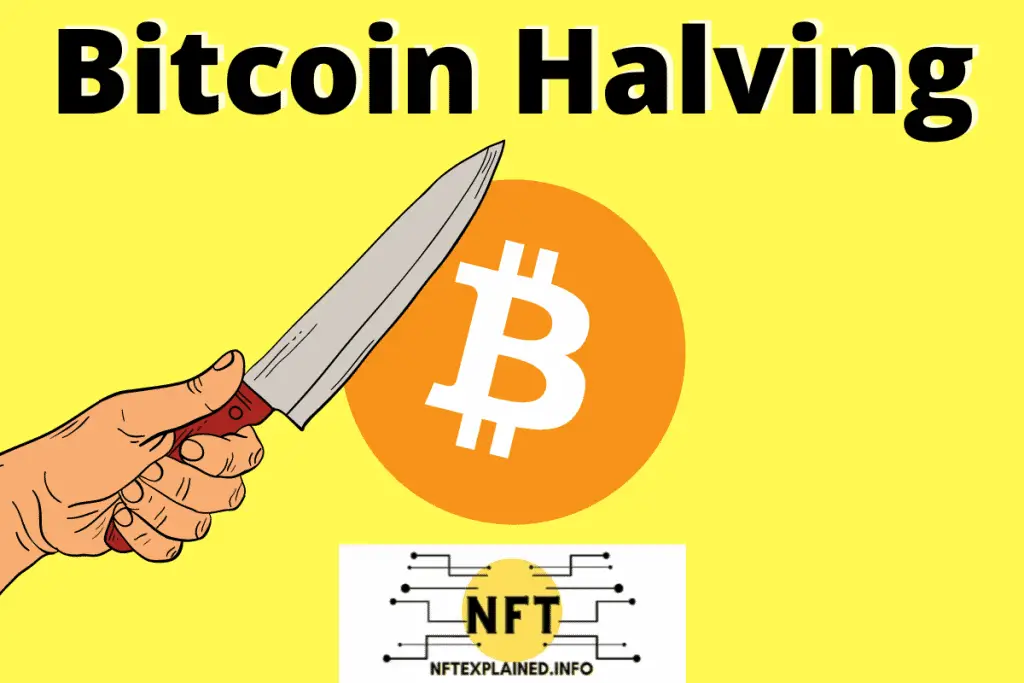
NFTexplained.info is a team of long term crypto investors who are well versed in the NFT space. In this article, we will thoroughly explain what the Bitcoin halving is, why it is done, the impact it has on price, and much more.
The Bitcoin halving occurs when 210,000 blocks have been minted – or brought into circulation – an event that typically occurs every four years. After each halving, miners’ rewards are cut in half for verifying transactions; this reduces the BTC brought into circulation while theoretically increasing demand.
Bitcoin started in 2009 by Satoshi Nakamoto who created a protocol which allows for the mining (creation) of a finite supply of Bitcoin. To be exact, there will only ever be 21 million Bitcoin in circulation; currently only (approximately) 10% of Bitcoins remains unminted or not in circulation. As of today, there are approximately 19 million Bitcoin in circulation.
Our team should note that minting means an asset is brought onto the blockchain and into circulation. A more in depth guide to understanding minting – with a focus on minting NFTs – can be found here.
The thought process Satoshi Nakamoto likely had behind the halving is that the reduction of Bitcoin brought into circulation will increase demand and therefore price.
As an illustrative example, we can look at precious metals. The price for precious metals is dependent on a combination of both supply and demand. If the amount of precious metal being brought into circulation decreased while demand remained the same (or even increased) the price would theoretically go up.
Now, our team will take a further look into halvings effect on the price of Bitcoin.
Does The Halving Of Bitcoin Increase Its Price?
Historically, the halving of Bitcoin has caused the price to increase. History has shown that a price increase does not occur immediately after the halving and that prices are volatile before and after the halving occurs. However, historically prices have typically increased 6 to 12 months after the halving.
Although the halving causes the reward for mining Bitcoin to be cut in half, miners are still incentivised to continue working as the reward becomes greater (due to the price increase) as the supply is constrained.
Our team will also examine the dates of Bitcoin halvings.
When Is The Next Bitcoin Halving?
The exact date of the Bitcoin halving is never set in stone as it occurs whenever 210,000 blocks have been minted/created – or brought into circulation. History has shown that this typically occurs every four years – starting in 2012 and then 2016, 2020, and so on until (likely) 2140 which would be the last halving.
2140 would be the 64th and last halving in which no new Bitcoins would be minted or created. Experts have noted that this would likely decrease the network strength of Bitcoin as there will be less validators.
A Quick History
| 2009 | Mining rewards = 50 BTC per block |
| 2012 | 1st halving. Mining reward = 25 BTC |
| 2016 | 2nd halving. Mining reward = 12.5 BTC |
| 2020 | 3rd halving. Mining reward = 6.26 BTC |
| 2140 | 64th & final halving |
Bitcoin runs on a proof of work blockchain consensus algorithm; learn more about that and the proof of stake consensus algorithm here. The linked article explores the energy consumption of the proof of work and proof of stake algorithms with a specific focus on NFT transactions.
After the last Bitcoin halving, miners will be incentivised to continue working as they will be paid a fee for verifying any transaction that occur on the network. Our team predicts that by that point in time, Bitcoin will be more of a store of value as history has shown us that decentralized applications are more commonly built atop the Ethereum network. This implies there will likely be considerably fewer transactions on the Bitcoin network.
Recent statistics have shown that the Bitcoin network sees roughly 250,000 transactions a day while Ethereum sees just over a million.
To conclude our article, our team will take a look at Ethereum and how that blockchains’ supply works.
Does Ethereum Have A Halving?
Ethereum has no limit on its total supply, unlike Bitcoin which has a finite supply of 21 million. Ethereum currently has approximately 122 million tokens in circulation with a limit of 18 million additional tokens released each year per its initial sale terms from 2014.
If you found our content helpful please consider following our team on Instagram, Twitter & TikTok! As well as subscribe to our YouTube!
Additionally, please consider supporting our team’s content creation through doing business with our partners: Trade stocks & crypto on Webull – get 2 free stocks. Buy a Ledger hardware wallet. U.S. users can get a crypto trading discount on Binance!

